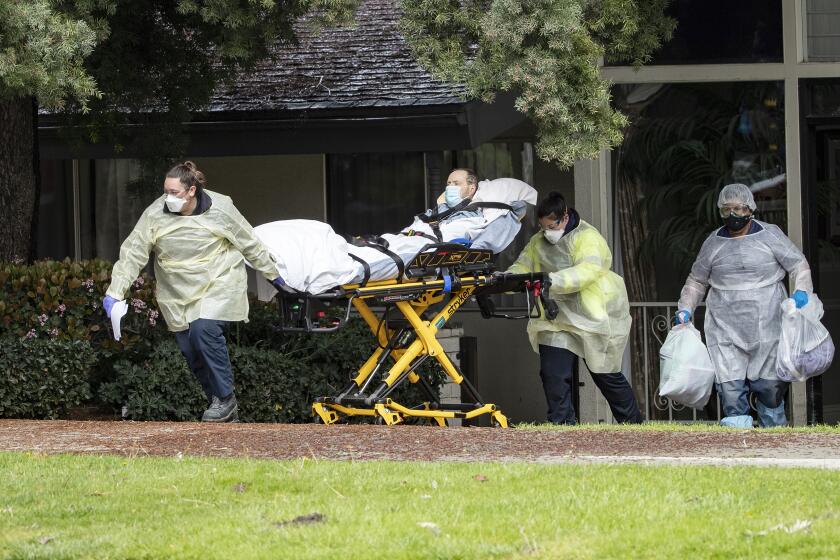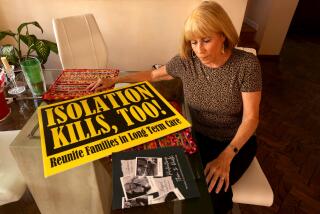Coronavirus outbreaks ravage nursing homes again, even after Newsom safety measures
- Share via
After a steady slide in the statewide number of new coronavirus infections at skilled nursing homes, facilities in Santa Cruz and Shasta Counties are grappling with severe outbreaks, with several dozen people at both places testing positive and residents dying of COVID-19.
The outbreaks raise questions on whether a May directive by state health officials, requiring regular testing of nursing home residents and staff, is being comprehensively implemented. Some watchdogs fear another spike could be in the offing at facilities that care for some of California’s most frail and vulnerable.
“Something is terribly wrong because they shouldn’t be having deaths,” Charlene Harrington, a professor emeritus at UC San Francisco who studies skilled nursing facilities, said Thursday. “There is a breakdown.”
At the Watsonville-Post Acute Center in Santa Cruz County, 61 people, including nine staff members, have tested positive since mid-September. Nine residents, whose ages ranged from the low 70s to 90s, have died, county health spokeswoman Corinne Hyland said Tuesday.
The facility is licensed for 95 beds.
In Redding, the Windsor Redding Care Center, another skilled nursing home, also is coping with an outbreak. Sixty residents and 20 staff members have contracted the virus, and seven have died from COVID-19, said Shasta County Health and Human Services spokeswoman Kerri Schuette.
Patricia McGinnis, executive director of California Advocates for Nursing Home Reform, said new California testing requirements imposed on nursing homes were being followed only sporadically and with little follow-up enforcement from the state.
In addition, rapid antigen tests the federal government has sent to nursing homes recently have been “absolutely useless,” she said. They produce too many false results.
State officials did not immediately respond to a request for comment.
State records show that about a half-dozen facilities across the state have significant outbreaks, and more have minor ones. Though the worst toll of the virus for elder care and skilled nursing facilities came early in the pandemic, infection numbers crept up again in August before once again declining in California.
In July and August, there were about 1,000 deaths a month in nursing homes and assisted living facilities, according to The Times’ coronavirus tracker. That number dipped to 562 in the month of September, according to the tracker. But danger persists. Over the last week, those facilities have averaged 142 new cases and 13.7 new deaths per day.
Hyland said the Watsonville facility had been following state guidelines for employee testing, which exposed the outbreak. The center reported an infected resident on Sept. 17. An outbreak at a nursing home is defined as an infection in one resident. Visitors have been barred during the pandemic, she said.
“It spread pretty quickly,” Hyland said. “Unfortunately, this is a very vulnerable population.”
Dr. David Ghilarducci, deputy health officer for Santa Cruz County, said the county’s public health staff was working closely with the facility to control the outbreak.
With skilled nursing homes hit particularly hard by the COVID-19 pandemic, Gov. Gavin Newsom on Tuesday signed a law requiring the facilities in California to report disease-related deaths to health authorities within 24 hours during declared emergencies.
Santa Cruz County health officials have been visiting the facility daily to review protocols on isolation, quarantine, testing and screening, and to respond to requests for more resources.
Officials from the California Department of Public Health also have made multiple visits to the facility to assess the situation and make recommendations, and the California National Guard is also providing help, the county said.
Because many nursing home employees work in more than one facility, the county immediately alerted other homes of the outbreak, Hyland said. She added that the county was tracing the contacts of the infected.
“This is really a large outbreak,” Hyland said. “We haven’t seen this sort of thing in our county until now.”
The latest maps and charts on the spread of COVID-19 in California.
The Watsonville center’s website has reported previous infections in the past but in small numbers. The website indicates that past infections have been among employees.
Gerald E. Hunter, the facility’s administrator, said on the website that there were 23 residents and four staff members who were still positive for the virus on Oct. 5. He said the county’s numbers reflected the total infected since the outbreak started.
“Each day we evaluate all of our residents following CDPH and County of Santa Cruz guidelines to determine whom meets the criteria to be transferred out of the unit,” said Hunter on the website. He did not respond to a request for an interview.
Shasta County’s Schuette said the Windsor Redding Care Center was not accepting visitors when the outbreak occurred. The county and state public health teams, she said, were working with the facility to control the infections.
To date, nursing homes and senior facilities have accounted for 7% of California’s coronavirus cases, but 36% of its deaths, according to The Times’ coronavirus tracker.
On Sept. 29, Gov. Gavin Newsom signed a law requiring skilled nursing facilities in California to report disease-related deaths to health authorities within 24 hours during declared emergencies.
The law was written in response to concerns that health agencies were slow to respond to outbreaks because they did not receive timely information about the facilities.
Earlier, in May, California required testing of all residents and staff in nursing facilities to halt the spread of the coronavirus. The effect has varied.
“It depends on the place, it depends on the facility, and I am not sure there is a lot of follow-up,” said McGinnis, the nursing home reformer.
More to Read
Sign up for Essential California
The most important California stories and recommendations in your inbox every morning.
You may occasionally receive promotional content from the Los Angeles Times.














